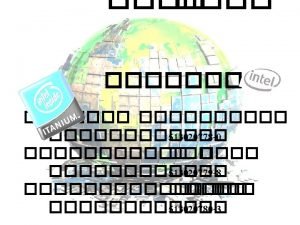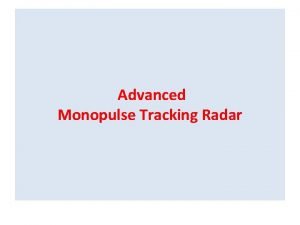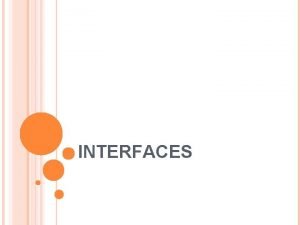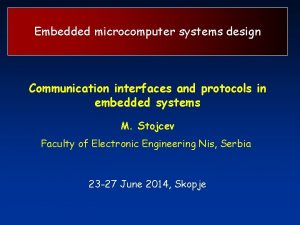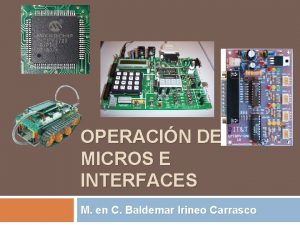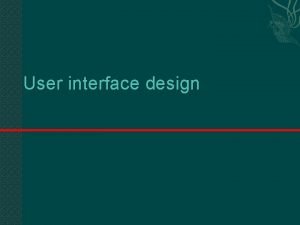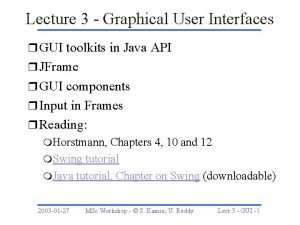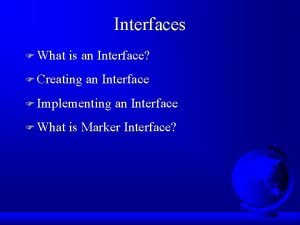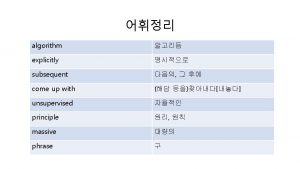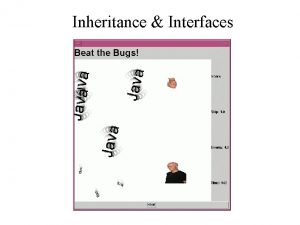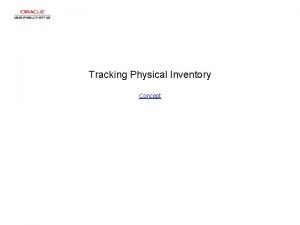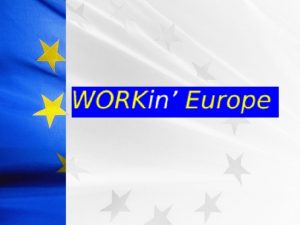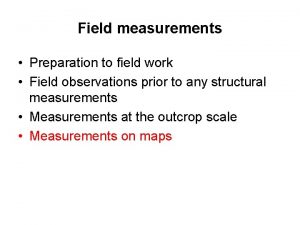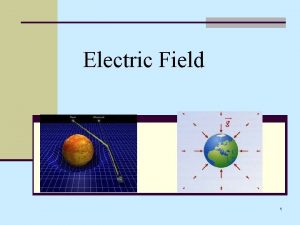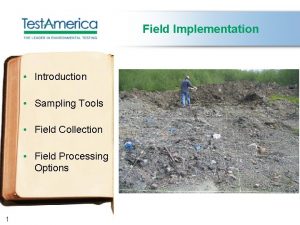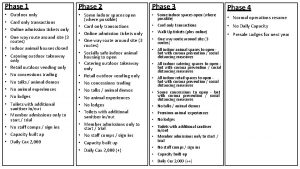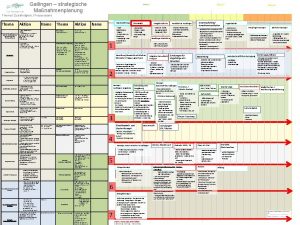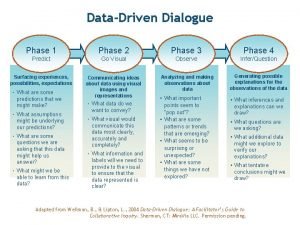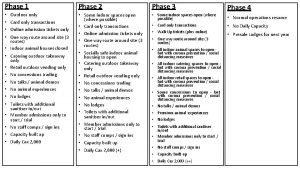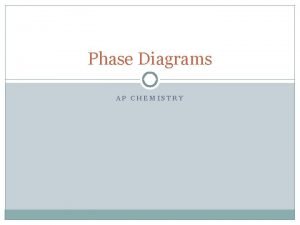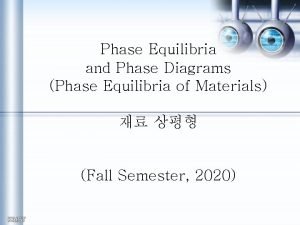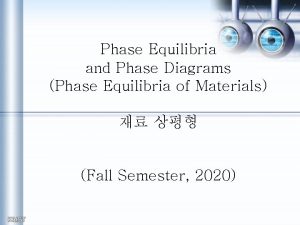Phase Field Modeling Instead of tracking interfaces explicitly






























- Slides: 30

Phase Field Modeling • Instead of tracking interfaces explicitly, the phase field method tracks the values of “order parameters” • The value of order parameter remains uniform in one phase, and continuously transitions to another uniform value in the another phase • The locations of interfaces are automatically defined by the transitioning region of the order parameter • Wide variety of applications including solidification, precipitation, grain growth, and batteries Multiphase systems Center for PRedictive Integrated Structural Materials. Polycrystalline materials Science

Motivation and Requirements for the PRISMS Phase Field Code • Microstructure simulations often require very large calculations • These are terascale computational problems with 106 to 109 DOF • For grain growth, need the ability to track 100 s of grains • Many different governing equations fall under the umbrella of “phase field modeling”, need flexibility • Finite Element Method – Easily allows mesh adaptivity, arbitrary geometries, and high order of accuracy – Can build from well-established community codes (e. g. deal. II) – Allows a shared toolset with PRISMS-Plasticity and PRISMS-RSDFT – However, need a low memory approach to compete with finite difference Center for PRedictive Integrated Structural Materials Science 2

PRISMS-PF: An Open Source, Finite Element, General Purpose Phase-Field Platform (github. com/prisms-center/phase. Field) User-Friendly: High-Performance: Simple interface to solve an arbitrary number of PDEs Detailed user guide 11 applications (and counting) to get you started Ideal scaling for >1, 000 processors Matrix-free method permits >109 DOF Adaptive meshing Competitive performance with finite difference (even without adaptive meshing) Center for PRedictive Integrated Structural Materials Science

Structure of PRISMS-PF • Core library – Generates mesh, does the finite element calculation, outputs files, etc. • Apps – Each app is a directory that contains (at least) three input files • parameters. h: Numerical parameters, including meshing options, time step, etc. • equations. h: Governing equations • ICs_and_BCs. h: Initial conditions and boundary conditions – Copy and paste an app directory to create a new app • Tests – Suite of unit and regression tests Center for PRedictive Integrated Structural Materials Science

User’s Guide • Instructions for downloading and installing PRISMS-PF and prerequisites • Instructions for running the pre-built applications and visualizing the results • A description of the input files and how to create custom applications Center for PRedictive Integrated Structural Materials Science

Three Types of PRISMS-PF Users 1. Uses PRISMS-PF applications – No C++ knowledge needed – No deal. II knowledge needed 2. Creates PRISMS-PF applications – Minimal C++ knowledge needed – No deal. II knowledge needed 3. Extends PRISMS-PF itself – C++ knowledge needed – deal. II knowledge needed Center for PRedictive Integrated Structural Materials Science

Phase Field Modeling at the PRISMS Center Mg-RE Precipitates Precipitation near Grain Boundaries Strong Interfacial Energy Anisotropy Spinodal Decomposition in Strained Thin Films (Non-PRISMS) Center for PRedictive Integrated Structural Materials Science 7

PRISMS Center Precipitate Use Case Atomic scale constitutive laws Dislocation Dynamics (LLNL-Para. DIS) Real Space DFT (PRISMS-RSDFT) Statistical Mechanics (CASM) Crystal Plasticity (PRISMS-Plasticity) Continuum Plasticity (PRISMS-Plasticity) Phase Field (PRISMS-PF) Mechano-Chemistry (PRISMS-MC*) Fourier Space DFT (VASP) Phase Diagrams (CASM/CALPHAD) Phase Field Crystal (PRISMS-PFC*) Experiments Center for PRedictive Integrated Structural Materials Science Experiments (slip, twinning, crack, etc. ) 8

Example Use Case: Precipitation Dislocation Dynamics (LLNL-Para. DIS) Statistical Mechanics (CASM) Phase Field (PRISMS-PF) • CASM submits VASP calculations and performs cluster expansions • CASM passes homogenous free energies, interfacial energies, mechanical properties to PRISMS-PF • PRISMS-PF predicts precipitate microstructure, validated by experiments • PRISMS-PF passes microstructure to Para. DIS to calculate CRSS Fourier Space DFT (VASP) Experiments Center for PRedictive Integrated Structural Materials Science 9

Precipitates in Mg-RE Alloys • Mg alloys are of interest for lightweighting in automotive and aerospace applications • Mg-RE alloys, such as Mg-Nd and Mg-Y have among the best mechanical properties of Mg alloys • β’’’ precipitates with habit planes perpendicular to the basal plane block dislocation motion Plots courtesy E. Deda, A. Githens (UM) Schematics: J. F. Nie, Met. Trans. A, 43 A, 3891 (2012) Center for PRedictive Integrated Structural Materials Science

Experimental Motivation: The Precipitation Sequence GP β 1 GP β’’’ Center for PRedictive Integrated Structural Materials Science β’’’

First-principles: Metastable hcp ground states 2 nm 2 nm Sitzman, Marquis Center for PRedictive Integrated Structural Materials Science

Why are the β’’’ orderings observed? Center for PRedictive Integrated Structural Materials Science

Two Types of β’ Structures with Different Expected Behavior Center for PRedictive Integrated Structural Materials Science

Predictions for the other Mg-RE alloys Center for PRedictive Integrated 15 Structural Materials Science

Phase Field Model Can Calculate Equilibrium Shape and Composition • Use inputs from first principles calculations to predict Mg-Nd β’’’ shape and composition • No fitting parameters • Yields a lenticular precipitate Center for PRedictive Integrated Structural Materials Science

Simulated composition within experimental range, suggests β’’’ structure 0. 250 β’’ XNd 0. 225 0. 200 • Simulated composition 0. 138– 0. 146 Nd • Notably elevated above β’ composition 0. 175 • Consistent with experimental range [1], 0. 150 β’ 0. 125 0. 00 0. 125– 0. 167 Nd 20. 00 40. 00 60. 00 80. 00 Length <001> (nm) Hex Row Zig-zag Row Alternating hexes and zig-zags would be 0. 15 Nd [1] Natarajan et al. , Acta Mater. 2016 Center for PRedictive Integrated Structural Materials Science

Quantitative Comparison to Experiments Comparing predicted equilibrium dimensions to experimental dimensions, including the effect of uncertainty Center for PRedictive Integrated Structural Materials Science

Non-Equilibrium Effects on Morphology Simulation of two precipitates in this configuration demonstrates this mechanism: Growth along <010> could be impeded by a neighboring precipitate of another variant <010> <100> Center for PRedictive Integrated Structural Materials Science

Summary: Precipitate Use Case • Example of the ICME methodology in action • Brings together first principles calculations, phase field simulations, and experiments • Obtain fundamental mechanistic understanding of the precipitates in Mg-RE alloys and a platform for microstructure prediction • Effort underway to link these capabilities to dislocation dynamics and crystal plasticity to predict precipitate strengthening Natarajan et al. , On the early stages of precipitation in dilute Mg-Nd alloys, Acta Mater. 108 (2016). Natarajan and van der Ven, A unified description of ordering in HCP Mg-RE alloys, Acta Mater. 124 (2017). Solomon et al. , Early precipitate morphologies in Mg-Nd-Zr alloys, Scripta Mater. 128 (2017) De. Witt et al. , Misfit-Driven β''' Precipitate Composition and Morphology in Mg-Nd Alloys, Acta Mater. (submitted) Center for PRedictive Integrated Structural Materials Science

PRISMS Annual Workshop • PRISMS Center holds workshops annually, along with training sessions • Next workshop: Ann Arbor, MI – August 14 -16: PRISMS Workshop Software Training – August 17 -18: PRISMS Center Workshop Technical Symposia • Limited financial aid is available – contact me! Center for PRedictive Integrated Structural Materials Science

Summary • The PRISMS Center is focused on providing new computational tools and a framework for the structural metals community and demonstrating on advanced Mg alloys. • Working together we are making great progress and generating: - Exciting new science! - Software: Available on Git. Hub - Information via Materials Commons: Stay Tuned • We encourage you to use and co-develop these tools and join us at our next workshop Aug 14 -18, 2017. Center for PRedictive Integrated Structural Materials Science

Thanks! Find us online at: prisms-center. org Funding for the PRISMS Center is provided by the US Dept. of Energy, Office of Basic Energy Sciences under award #DE-SC 0008637 Center for PRedictive Integrated Structural Materials Science

Center for PRedictive Integrated Structural Materials Science

Performance Benchmarks vs. Finite Difference • Compared PRISMS-PF to finite difference code – FD code: MPI-parallelized, written in Fortran, uses second-order centered finite differences, explicit time stepping – Test problem: coupled Cahn-Hilliard-Allen-Cahn growing particle, 128 x 128 grid points • Direct comparison of PRISMS-PF with 1 st order elements, 16 cores PRISMS-PF is 3. 5 x slower than FD • Increase element order in PRISMS-PF to 2, 16 cores PRISMS-PF is 4. 5 x faster than finite difference – Increased accuracy means we can increase element size by 3. 2 x without increasing error – Increased element size increases the maximum stable time step Center for PRedictive Integrated Structural Materials Science 25

Performance Benchmarks vs. Finite Difference Wall Time (s) 10000 FD 1000 FD Ideal PRISMS-PF (p=2) 100 PRISMS-PF (p=2) Ideal PRISMS-PF (p=1) Ideal 10 1 Cores • Close to ideal scaling behavior until between 17 k and 8 k Do. F/processor • These simulations do not include adaptive meshing • With that we can expect even better performance (~15 x for precipitate simulations) Center for PRedictive Integrated Structural Materials Science 26

Acknowledgements • Special Thanks to: Tracy Berman, Jake Adams, Ellen Sitzmann Solomon and all the other graduate students and post-docs who have contributed their time, ideas and tears. • Work supported by US Do. E, Office of Basic Energy Sciences, Division of Materal Sciences and Engineering, under Award #DE-SC 0008637 as part of the Center for PRedictive Integrated Structural Materals Science, the PRISMS Center, at the University of Michigan. Center for PRedictive Integrated Structural Materials Science

CASM: Statistical Mechanics (Faculty lead: Van der Ven) Features (*current public release) First-principles Electronic Structure • • Algorithmic construction of effective Hamiltonian Configurational Cluster Expansion Phonon Hamiltonian • Symmetry analysis* Automated DFT job submission* Convex hull* Cluster expansions*, phonons, anharmonic lattice dynamics Monte Carlo simulation Anharmonic vibrational Cluster Expansion (kinetic) Monte Carlo Center for PRedictive Integrated Structural Materials Science

PRISMS-PF (Phase Field) Open-source finite element phase field software: – – Matrix-free approach allows billions of DOF Arbitrarily high order spectral elements Near-ideal scaling for hundreds/thousands of cores 4 x faster than finite difference for Allen-Cahn test problem Available physics: – Cahn-Hilliard dynamics (for conserved quantities) – Allen-Cahn dynamics (for non-conserved quantities) – Mechanics Simulation with 1, 000 elliptical precipitates (108 DOF) Target applications: – Precipitate evolution • Heterogeneous mechanical properties • Composition-dependent misfit strain • Nucleation & adaptive mesh/element order* – Grain growth and recrystallization* *Coming in August 2016 Release β’’’ precipitate in Mg-Nd alloy Center for PRedictive Integrated Structural Materials Science

PRISMS-Plasticity (CPFE) (Faculty lead: Sundararaghavan) Features: • Massively Parallel • deal. II based • Finite Strain • Arbitrary boundary conditions • Library of hardening laws: Initial Microstructure Future releases: • Kinematic Hardening • Rate Dependence • Dynamic Recrystallization • UMAT format Representative Texture ODF Weakly basal 750 grains (600*600 μm) CPFE simulation (32*32*32 elements)=107811 DOF’s Computational cost ~ 96 CPU Hours 200 time steps (~1000 solves) Center for PRedictive Integrated Structural Materials Science
 Role modeling theory
Role modeling theory Relational modeling vs dimensional modeling
Relational modeling vs dimensional modeling Explicit textual evidence?
Explicit textual evidence? Intel itanium 2
Intel itanium 2 Stated explicitly
Stated explicitly Monopulse tracking radar
Monopulse tracking radar Softwares can_ -in designing and modeling in every field
Softwares can_ -in designing and modeling in every field Stationary phase in gas chromatography
Stationary phase in gas chromatography Csce 441
Csce 441 Phase to phase voltage
Phase to phase voltage Normal phase vs reverse phase chromatography
Normal phase vs reverse phase chromatography Normal phase vs reverse phase chromatography
Normal phase vs reverse phase chromatography Hplc reverse phase vs normal phase
Hplc reverse phase vs normal phase Difference between phase voltage and line voltage
Difference between phase voltage and line voltage Mobile phase and stationary phase
Mobile phase and stationary phase Hplc detector types
Hplc detector types Java static import
Java static import Ms bts bsc msc
Ms bts bsc msc Expressive interfaces
Expressive interfaces User interfaces design dc
User interfaces design dc Communication interface in embedded systems
Communication interface in embedded systems Micros e interfaces
Micros e interfaces Which is not an objective of designing interfaces?
Which is not an objective of designing interfaces? Industrial interfaces
Industrial interfaces Gui for r
Gui for r Expressive interfaces
Expressive interfaces Interface and dialogue design
Interface and dialogue design Expressive interface
Expressive interface Interface f
Interface f Why are user interfaces hard to implement
Why are user interfaces hard to implement Joe hogan openet
Joe hogan openet



